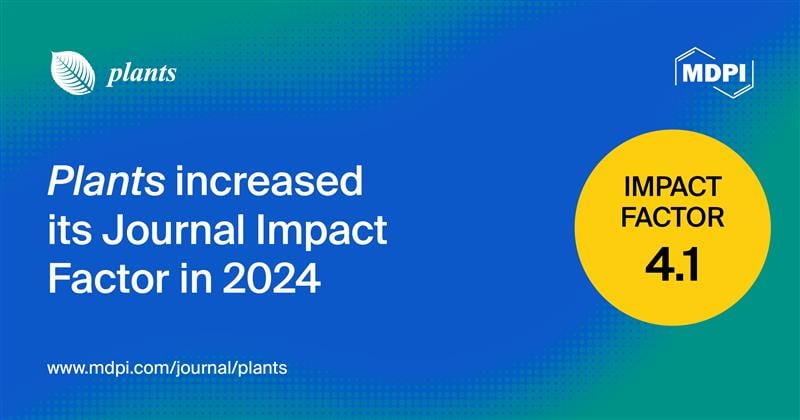Journal Description
Plants
Plants
is an international, scientific, peer-reviewed, open access journal on plant science published semimonthly online by MDPI. The Australian Society of Plant Scientists (ASPS), the Spanish Phytopathological Society (SEF), the Spanish Society of Plant Biology (SEBP), the Spanish Society of Horticultural Sciences (SECH) and the Italian Society of Phytotherapy (S.I.Fit.) are affiliated with Plants and their members receive a discount on the article processing charges.
- Open Access— free for readers, with article processing charges (APC) paid by authors or their institutions.
- High Visibility: indexed within Scopus, SCIE (Web of Science), PubMed, PMC, PubAg, AGRIS, CAPlus / SciFinder, and other databases.
- Journal Rank: JCR - Q1 (Plant Sciences) / CiteScore - Q1 (Ecology, Evolution, Behavior and Systematics)
- Rapid Publication: manuscripts are peer-reviewed and a first decision is provided to authors approximately 18.9 days after submission; acceptance to publication is undertaken in 2.4 days (median values for papers published in this journal in the second half of 2024).
- Recognition of Reviewers: reviewers who provide timely, thorough peer-review reports receive vouchers entitling them to a discount on the APC of their next publication in any MDPI journal, in appreciation of the work done.
Impact Factor:
4.1 (2024);
5-Year Impact Factor:
4.5 (2024)
Latest Articles
Can Sweet Maize Act as a Trap Crop for Fall Armyworm?
Plants 2025, 14(13), 1944; https://doi.org/10.3390/plants14131944 (registering DOI) - 25 Jun 2025
Abstract
Among various plants, corn is the primary host damaged by Spodoptera frugiperda J. E. Smith (Lepidoptera: Noctuidae). After long-term regional colonization, its larvae feed on sweet waxy corn and fresh corn for extended periods. A question arises: Does long-term feeding on different corn
[...] Read more.
Among various plants, corn is the primary host damaged by Spodoptera frugiperda J. E. Smith (Lepidoptera: Noctuidae). After long-term regional colonization, its larvae feed on sweet waxy corn and fresh corn for extended periods. A question arises: Does long-term feeding on different corn varieties affect their rhythms? Currently, there are no reports addressing these issues. To facilitate the formulation of effective prevention and control measures, Zhengdan 958 and Zhenghuangnuo were selected as representative varieties of normal and sweet waxy corn, respectively, for laboratory experiments. S. frugiperda were fed the leaves of these two corn types over nine consecutive generations, thereby establishing distinct S. frugiperda strains associated with each corn variety. Additionally, a strain fed an artificial diet served as the control group. Through a comparative analysis of the emergence, movement, nutritional foraging, dormancy, mating, and oviposition behaviors of adult fall armyworms from different populations, differences in the six behavioral peak times among the strains were identified. RT-qPCR analysis indicated significant differences in the expression levels of four circadian clock genes across different populations and tissues of the fall armyworm. Feeding on different host plants influenced the expression of circadian clock genes and their associated behavioral rhythms. Our study showed that sweet corn is more conducive to pupation, mating, and oviposition. Because of these differences in adult insect rhythms, sweet corn may have an impact on the reproduction of fall armyworms in the Huang–Huai–Hai corn-planting region.
Full article
(This article belongs to the Special Issue Functional Plants for Ecological Control of Agricultural Pests)
►
Show Figures
Open AccessArticle
Meta-QTL Analysis and Genes Responsible for Plant and Ear Height in Maize (Zea mays L.)
by
Xin Li, Xiaoqiang Zhao, Siqi Sun, Kejin Tao and Yining Niu
Plants 2025, 14(13), 1943; https://doi.org/10.3390/plants14131943 - 24 Jun 2025
Abstract
Plant height (PH) and ear height (EH) are closely related to dense planting characteristics and lodging resistance of maize (Zea mays L.). Increasing the planting density will lead to changes in the structural characteristics of maize plants, such as reduced stem length
[...] Read more.
Plant height (PH) and ear height (EH) are closely related to dense planting characteristics and lodging resistance of maize (Zea mays L.). Increasing the planting density will lead to changes in the structural characteristics of maize plants, such as reduced stem length and stem strength, thereby influencing their yield and quality. Therefore, analyzing the genetic basis of PH and EH in maize can provide valuable information for cultivating ideal plant types with suitable PH and EH. This study aims to identify stable genomic regions and candidate genes associated with PH and EH in maize through Meta-QTL (MQTL) analysis. A total of 187 original QTLs were collected from 13 published articles on QTL localization related to maize PH and EH. A high-density consistency map with a total length of 6970.00 cM was constructed, and 152 original QTLs were successfully projected into the consistency map. The remaining 35 QTLs could not be projected onto the consistency map, which may be attributed to a lack of common markers between the original and consistency map or to the QTL exhibiting low phenotypic variance explained (PVE), resulting in large confidence intervals (CIs). Then, 29 MQTLs were identified on 10 chromosomes via meta-analysis. Among them, the three identified MQTLs, i.e., MQTL4-1, MQTL4-2, and MQTL6-1, were specifically controlled by maize EH. Further analysis achieved 188 candidate genes in all MQTL intervals, which were related to maize plant development and morphogenesis. Meanwhile, the gene ontology (GO) enrichment analysis revealed that these candidate genes were involved in 77 GO annotations. These findings thus will help us better understand the molecular genetic basis of maize PH and EH under various environments, and thereby achieve an increased yield with maize dense planting breeding.
Full article
(This article belongs to the Special Issue Genetic Diversity and Population Structure of Plants)
►▼
Show Figures
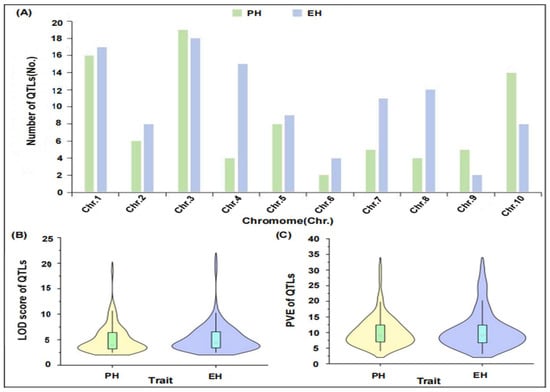
Figure 1
Open AccessReview
Impact of Water Deficit Stress on Brassica Crops: Growth and Yield, Physiological and Biochemical Responses
by
Vijaya R. Mohan, Mason T. MacDonald and Lord Abbey
Plants 2025, 14(13), 1942; https://doi.org/10.3390/plants14131942 - 24 Jun 2025
Abstract
Drought including both meteorological drought and water deficiency stress conditions is a major constraint on global agricultural productivity, particularly affecting Brassica species, which are vital oilseed and vegetable crops. As climate change intensifies, understanding plant responses to drought is crucial for improving drought
[...] Read more.
Drought including both meteorological drought and water deficiency stress conditions is a major constraint on global agricultural productivity, particularly affecting Brassica species, which are vital oilseed and vegetable crops. As climate change intensifies, understanding plant responses to drought is crucial for improving drought resilience. Drought stress impacts Brassica crops at multiple levels, reducing germination rates, impairing physiological functions such as photosynthesis and water-use efficiency, and triggering oxidative stress due to the accumulation of reactive oxygen species. To counteract these effects, Brassica plants employ various adaptive mechanisms, including osmotic adjustment, antioxidant defense activation, and hormonal regulation. Recent research has explored molecular and physiological pathways involved in drought tolerance, revealing key physiological changes and biochemical markers that could be targeted for crop improvement. This review summarizes the latest findings on the physiological, biochemical, and molecular responses of Brassica crops to drought stress, with an emphasis on adaptive mechanisms and potential drought mitigation strategies. Additionally, future research directions are proposed, focusing on integrating molecular and agronomic approaches to enhance drought resilience in Brassica species.
Full article
(This article belongs to the Special Issue Plant Functioning Under Abiotic Stress)
Open AccessArticle
Resistance of Alternaria spp. Causing Strawberry Black Spot to Boscalid in China
by
Tao Li, Wenbin Yu, Ji Feng, Chengxin Mao, Hong Yu, Aichun Liu and Chuanqing Zhang
Plants 2025, 14(13), 1941; https://doi.org/10.3390/plants14131941 - 24 Jun 2025
Abstract
Strawberry black spot, caused by Alternaria spp., is an emerging disease that threatens both leaves and fruits during strawberry growth and postharvest storage. This study investigated the boscalid sensitivity of 49 Alternaria isolates collected from symptomatic strawberry leaves. Boscalid has been widely used
[...] Read more.
Strawberry black spot, caused by Alternaria spp., is an emerging disease that threatens both leaves and fruits during strawberry growth and postharvest storage. This study investigated the boscalid sensitivity of 49 Alternaria isolates collected from symptomatic strawberry leaves. Boscalid has been widely used to control diseases in strawberry in China for several years. The EC50 values for the tested isolates ranged from 0.0884 to 266.3289 µg/mL, indicating that most isolates exhibited varying levels of resistance to boscalid based on resistance ratio values. A substitution of SDHC-H134R was detected from most high-resistance isolates. Fitness cost assessment revealed that highly resistant isolates had a reduced conidial germination rate; however, their mycelial growth and conidia production were increased. No significant virulence deficiency was observed, suggesting low fitness cost in resistant isolates. Furthermore, the highly resistant isolates exhibited positive cross-resistance to fluopyram and fluxapyroxad. Molecular docking analysis revealed that the SDHC-H134R mutation reduced the binding affinity between boscalid and mitochondrial complex II. These findings suggest that resistance management strategies, such as fungicide rotation or combinations of fungicides with different action modes, should be implemented to control strawberry diseases, minimizing the development of fungicide resistance and improving overall disease control efficacy.
Full article
(This article belongs to the Special Issue Fungicide Resistance in Plant Pathogens: Monitoring, Detection, Mechanisms and Management)
►▼
Show Figures
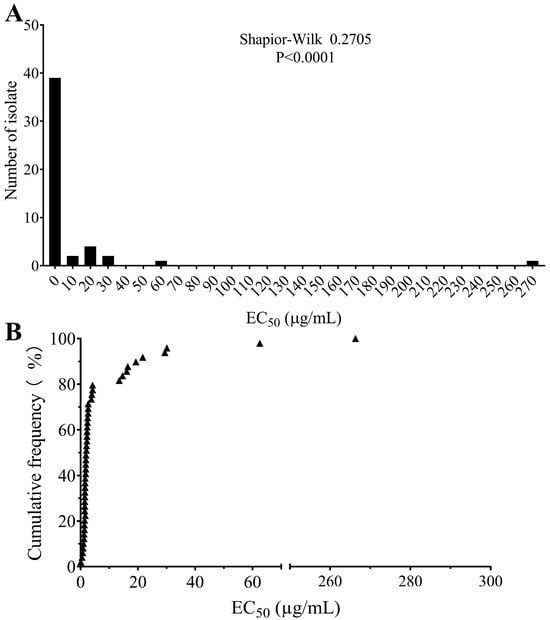
Figure 1
Open AccessReview
Celosia argentea: Towards a Sustainable Betalain Source—A Critical Review and Future Prospects
by
Preekamol Klanrit, Sudarat Thanonkeo, Poramaporn Klanrit, Poramate Klanrit, Kanchanok Mueangnak and Pornthap Thanonkeo
Plants 2025, 14(13), 1940; https://doi.org/10.3390/plants14131940 - 24 Jun 2025
Abstract
Betalains are nitrogen-containing, water-soluble, and non-toxic natural pigments found in various plant species. Among these, Celosia argentea (Amaranthaceae) has garnered attention as a significant source, accumulating substantial quantities of both red–purple betacyanins and yellow–orange betaxanthins. Impressively, betalain concentrations in C. argentea inflorescences can
[...] Read more.
Betalains are nitrogen-containing, water-soluble, and non-toxic natural pigments found in various plant species. Among these, Celosia argentea (Amaranthaceae) has garnered attention as a significant source, accumulating substantial quantities of both red–purple betacyanins and yellow–orange betaxanthins. Impressively, betalain concentrations in C. argentea inflorescences can reach up to 14.91 mg/g dry weight (DW), a level comparable to that reported in red beetroot. Beyond harvesting from inflorescences, betalains can also be produced using cell culture systems, which can yield even higher amounts, up to 42.08 mg/g DW. Beyond their role as vibrant natural colorants, betalains exhibit impressive health-promoting properties, most notably potent antioxidant activities. For instance, C. argentea inflorescence extracts demonstrate approximately 84.07% 2,2′-azino-bis(3-ethylbenzothiazoline-6-sulfonic acid) (ABTS) and 88.70% 2,2-diphenyl-1-picrylhydrazyl (DPPH) radical scavenging. Extracts derived from cell cultures show even higher scavenging capacities, reaching up to 99.28% for ABTS and 99.63% for DPPH, rivaling the antioxidant standard (ascorbic acid). Further research indicates additional potential benefits, including anti-inflammatory, antimicrobial, anticancer, antidiabetic, and hepatoprotective properties. This diverse bioactivity underpins their value across various industries. Betalains serve as natural colorants and functional ingredients in food and beverages, offer sustainable alternatives for textile dyeing, and hold therapeutic promise in cosmetics and pharmaceuticals. This review critically examines existing research on betalain production in C. argentea. Recognizing that research specific to C. argentea is less extensive compared with that on species such as Beta vulgaris and Hylocereus polyrhizus, this review analyzes its biosynthetic pathways, diverse biological properties, and wide-ranging applications. This is achieved by integrating available C. argentea-specific data with relevant insights drawn from these more broadly studied betalain sources. Furthermore, the review discusses perspectives on future research directions aimed at optimizing yield and exploring the full potential of betalains, specifically within C. argentea.
Full article
(This article belongs to the Special Issue Bioactive Compounds in Plants—2nd Edition)
►▼
Show Figures
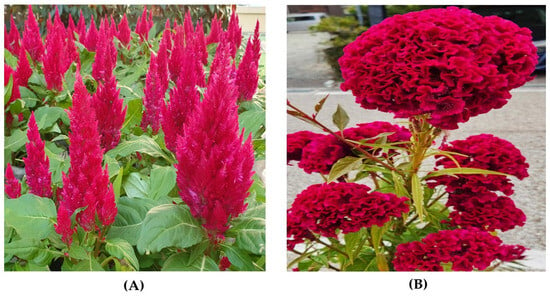
Figure 1
Open AccessArticle
Chemotypic and Seasonal Variations in Essential Oils from Mespilodaphne cymbarum (Kunth) Trofimov and Their Antibacterial and Antibiofilm Activities
by
Amanda Galdi Boaretto, Darlene Gris, Jéssica Scherer, Katyuce Souza Farias, Jean Carlo Quadros, Alexandre José Macedo, Carlos Alexandre Carollo and Denise Brentan Silva
Plants 2025, 14(13), 1939; https://doi.org/10.3390/plants14131939 - 24 Jun 2025
Abstract
This study investigated the essential oils (EOs) from leaf, bark, and fruit of Mespilodaphne cymbarum (Kunth) Trofimov (Lauraceae), focusing on their chemical composition and antimicrobial and antibiofilm activities. EOs were extracted from plants collected in the Amazon during dry and flood seasons and
[...] Read more.
This study investigated the essential oils (EOs) from leaf, bark, and fruit of Mespilodaphne cymbarum (Kunth) Trofimov (Lauraceae), focusing on their chemical composition and antimicrobial and antibiofilm activities. EOs were extracted from plants collected in the Amazon during dry and flood seasons and analyzed by gas chromatography–mass spectrometry. Although chemical differences were evident among plant organs and chemotypes, the influence of seasonality was not pronounced. Fruit EO was dominated by α- and β-santalene and limonene. Bark EO was rich in phenylpropanoids, including methyl eugenol, myristicin, and elemicin. Leaf EO showed the greatest metabolic diversity, with chemotype-specific variations. Leaf and bark EOs demonstrated superior antibacterial and antibiofilm activities compared to fruit EO, especially against Gram-positive bacteria such as Staphylococcus epidermidis, Staphylococcus aureus, and Micrococcus luteus. Chemotype-1 leaf and bark EOs inhibited S. epidermidis biofilm formation, while chemotype-2 reduced bacterial growth. The leaf EOs from both chemotypes reduced bacterial growth against S. aureus, and bark EO decreased biofilm formation. All leaf and bark EOs showed antibiofilm activity against M. luteus. These findings highlight the potential of M. cymbarum EOs as natural sources of bioactive compounds and emphasize the importance of chemotype and plant organ selection for optimized applications.
Full article
(This article belongs to the Special Issue Phytochemical Investigations for Drug Discovery, Development and Biotechnological Approaches for Health and Agriculture)
►▼
Show Figures

Figure 1
Open AccessArticle
Influence of Seed Coat Integrity on the Response of Pepper Seeds to Dielectric Barrier Discharge Plasma Treatment
by
Chanyanuch Sriruksa, Choncharoen Sawangrat, Sakon Sansongsiri, Dheerawan Boonyawan and Sa-nguansak Thanapornpoonpong
Plants 2025, 14(13), 1938; https://doi.org/10.3390/plants14131938 - 24 Jun 2025
Abstract
This study investigated the response of pepper seeds with varying seed coat conditions (SCs) to dielectric barrier discharge plasma treatment (PT). The experimental design was a split plot with three replications. The primary plot factor was the SC (normal seeds [NMS], nicking at
[...] Read more.
This study investigated the response of pepper seeds with varying seed coat conditions (SCs) to dielectric barrier discharge plasma treatment (PT). The experimental design was a split plot with three replications. The primary plot factor was the SC (normal seeds [NMS], nicking at the hilum part [NHP], and removed seed coat [RSC]), while the subplot factor was the plasma exposure time (0.4–2.0 s/cm), including a control, to determine the effects on seed viability, germination, and vigor. The results indicate that NMS seeds exhibit the highest performance in terms of seed viability. The NMS and NHP had statistically significantly higher seed germination, electrical conductivity, radical emergence, and germination index at 14 days after sowing, and the shoot length measured longer than RSC. Plasma exposure at 1.2 s/cm improved germination and vigor, whereas 2.0 s/cm exposure significantly decreased seed viability and increased the number of abnormal seedlings. The interaction between SC and PT significantly affected seedling abnormalities, with RSC seeds being more vulnerable to damage under prolonged exposure. These findings highlight the crucial role of seed coat integrity in maintaining seed quality and suggest that carefully controlled PT can be a promising and sustainable method to enhance pepper seed performance.
Full article
(This article belongs to the Section Plant Response to Abiotic Stress and Climate Change)
►▼
Show Figures

Figure 1
Open AccessArticle
Phenotypic Validation of the Cotton Fiber Length QTL, qFL-Chr.25, and Its Impact on AFIS Fiber Quality
by
Samantha J. Wan, Sameer Khanal, Nino Brown, Pawan Kumar, Dalton M. West, Edward Lubbers, Neha Kothari, Donald Jones, Lori L. Hinze, Joshua A. Udall, William C. Bridges, Christopher Delhom, Andrew H. Paterson and Peng W. Chee
Plants 2025, 14(13), 1937; https://doi.org/10.3390/plants14131937 - 24 Jun 2025
Abstract
Advances in spinning technology have increased the demand for upland cotton (Gossypium hirsutum L.) cultivars with superior fiber quality. However, progress in breeding for traits such as fiber length is constrained by limited phenotypic and genetic diversity within upland cotton. Introgression from
[...] Read more.
Advances in spinning technology have increased the demand for upland cotton (Gossypium hirsutum L.) cultivars with superior fiber quality. However, progress in breeding for traits such as fiber length is constrained by limited phenotypic and genetic diversity within upland cotton. Introgression from Gossypium barbadense, a closely related species known for its superior fiber traits, offers a promising strategy. Sealand 883 is an obsolete upland germplasm developed through G. barbadense introgression and is known for its long and fine fibers. Previous studies have identified a fiber length quantitative trait locus (QTL) on Chromosome 25, designated qFL-Chr.25, in Sealand 883, conferred by an allele introgressed from G. barbadense. This study evaluated the effect of qFL-Chr.25 in near-isogenic introgression lines (NIILs) using Advanced Fiber Information System (AFIS) measurements. Across four genetic backgrounds, NIILs carrying qFL-Chr.25 consistently exhibited longer fibers, as reflected in multiple length parameters, including UHML, L(n), L(w), UQL(w), and L5%. Newly developed TaqMan SNP diagnostic markers flanking the QTL enable automated, reproducible, and scalable screening of large populations typical in commercial breeding programs. These markers will facilitate the incorporation of qFL-Chr.25 into commercial breeding pipelines, accelerating fiber quality improvement and enhancing the competitiveness of cotton against synthetic fibers.
Full article
(This article belongs to the Special Issue Genetic Diversity and Molecular Marker Development for Cotton Breeding and Crop Improvement)
►▼
Show Figures

Figure 1
Open AccessArticle
Genome-Wide Analysis of the FNSII Gene Family and the Role of CitFNSII-1 in Flavonoid Synthesis in Citrus
by
Xinya Liu, Beibei Chen, Ling Luo, Qi Zhong, Chee How Teo and Shengjia Huang
Plants 2025, 14(13), 1936; https://doi.org/10.3390/plants14131936 - 24 Jun 2025
Abstract
Flavonoid synthases (FNSs) are key enzymes catalyzing the conversion of flavanones to flavonoids, yet their functions in citrus remain functionally uncharacterized. In this study, we identified three FNSII genes in the citrus genome. Phylogenetic analysis revealed that citrus FNSII genes share the closest
[...] Read more.
Flavonoid synthases (FNSs) are key enzymes catalyzing the conversion of flavanones to flavonoids, yet their functions in citrus remain functionally uncharacterized. In this study, we identified three FNSII genes in the citrus genome. Phylogenetic analysis revealed that citrus FNSII genes share the closest evolutionary distance with apple FNSII genes. Chromosomal localization demonstrated that the three FNSII genes are distributed across two out of nine chromosomes. Gene structure analysis indicated that the majority of motifs within these three FNSII genes are highly conserved. We cloned a gene called CitFNSII-1 from citrus. Transient overexpression of CitFNSII-1 in citrus leaves significantly increased flavonoid content, while simultaneous virus-induced silencing of CitFNSII-1 led to synchronously and significantly reduced gene expression levels and flavonoid content in citrus seedlings. Through the Agrobacterium rhizogenes-mediated genetic transformation system, overexpression of CitFNSII-1 was found to markedly enhance flavonoid accumulation in hairy roots, whereas knockout of CitFNSII-1 resulted in a significant decrease in flavonoid content in hairy roots. Further experiments verified an interaction between CitFNSII-1 and the Chalcone isomerase-1 (CHI-1) protein. The results demonstrated that the flavonoid accumulation patterns of CHI-1 and CitFNSII-1 are highly similar. In conclusion, this study advances the understanding of the flavonoid biosynthesis pathway in citrus and provides a theoretical foundation for molecular breeding strategies in citrus.
Full article
(This article belongs to the Special Issue Innovative Techniques for Citrus Cultivation)
►▼
Show Figures
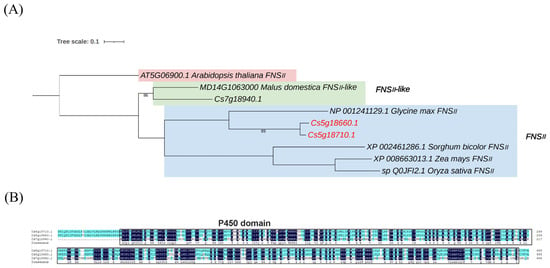
Figure 1
Open AccessReview
The Occurrence and Bioactivities of Amaryllidaceae Alkaloids from Plants: A Taxonomy-Guided Genera-Wide Review
by
G. David Lin, Pinky Vishwakarma, Paul N. Smith and Rachel W. Li
Plants 2025, 14(13), 1935; https://doi.org/10.3390/plants14131935 - 24 Jun 2025
Abstract
The distribution of Amaryllidaceae alkaloids, with a focus on their chemodiversity, has been reported previously, but not at a genera-wide diversity level. This review provides a comprehensive survey of the occurrence of Amaryllidaceae alkaloids across the genera of the Amaryllidaceae family. This survey
[...] Read more.
The distribution of Amaryllidaceae alkaloids, with a focus on their chemodiversity, has been reported previously, but not at a genera-wide diversity level. This review provides a comprehensive survey of the occurrence of Amaryllidaceae alkaloids across the genera of the Amaryllidaceae family. This survey is taxonomically guided by the National Center for Biotechnology Information (NCBI) Taxonomy Browser, with targeted keyword searches conducted in the Chemical Abstracts Service (CAS) SciFinder-n and PubMed. The family Amaryllidaceae comprises over 1214 species across three subfamilies: Agapanthoideae (1 genus, 5 species), Allioideae (3 genera plus 11 subgenera, 617 species), and Amaryllidoideae (58 genera plus 13 subgenera, 592 species). Amaryllidaceae alkaloids have been identified exclusively in 36 of the 58 genera and 6 of the 13 subgenera within the Amaryllidoideae subfamily. To date, more than 600 Amaryllidaceae alkaloids have been isolated, predominantly from this subfamily—hence the designation “Amaryllidaceae alkaloids”. These alkaloids display a wide spectrum of biological activities, including acetylcholinesterase inhibition, anti-inflammatory, antioxidant, antimicrobial, antidiabetic, and anticancer effects. A notable example is galanthamine (also known as galantamine), an FDA-approved drug marketed under the brand names Reminyl™ (Janssen Research Foundation, Beerse, Belgium, 2001) and Razadyne™ (Johnson & Johnson Pharmaceutical Research, New Brunswick, NJ, USA, 2004) for the treatment of mild to moderate Alzheimer’s disease, due to its potent acetylcholinesterase-inhibitory activity. Galanthamine has been isolated from species belonging to the genera Cyrtanthus, Galanthus, Leucojum, Lycoris, Narcissus, Ungernia, Chlidanthus, Crinum, Eucharis, Eustephia, Pancratium, and Phaedranassa. Lycorine is another widely distributed alkaloid found across multiple genera, and it has been extensively studied for its diverse bioactivities. Given the remarkable chemical diversity and bioactivity of Amaryllidaceae alkaloids, along with the many underexplored genera and species, further research into Amaryllidaceae species and their alkaloids is strongly warranted to support the discovery and development of novel therapeutic agents.
Full article
(This article belongs to the Special Issue Anti-inflammatory, Antioxidant, Antimicrobial, Antidiabetic, and Anticancer Activities of Medicinal Plants)
►▼
Show Figures
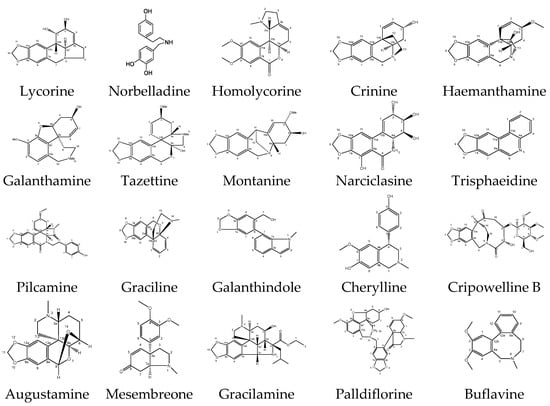
Figure 1
Open AccessArticle
Physiological and Yield Responses of Pepper (Capsicum annuum L.) Genotypes to Drought Stress
by
Theodora Ntanasi, Ioannis Karavidas, Dimitrios Savvas, George P. Spyrou, Evangelos Giannothanasis, Beppe Benedetto Consentino, Vasileios Papasotiropoulos, Leo Sabatino and Georgia Ntatsi
Plants 2025, 14(13), 1934; https://doi.org/10.3390/plants14131934 - 24 Jun 2025
Abstract
Drought stress is a critical abiotic constraint on agricultural productivity, particularly affecting crops like pepper (Capsicum annuum L.), which are highly susceptible to water deficits due to their physiological characteristics. The present study investigated the impact of a 40% reduction in irrigation
[...] Read more.
Drought stress is a critical abiotic constraint on agricultural productivity, particularly affecting crops like pepper (Capsicum annuum L.), which are highly susceptible to water deficits due to their physiological characteristics. The present study investigated the impact of a 40% reduction in irrigation on yield, macronutrient concentrations, and fruit quality across several pepper genotypes. The cultivars evaluated included two landraces, namely ‘JO109’ and ‘JO204’ (Capsicum annuum var. grossum), as well as the California cultivar ‘Yolo Wonder’ and the commercial F1 hybrid ‘Sammy RZ’, which served as controls. The experiment was conducted at the greenhouse facilities of the Laboratory of Vegetable Production, Agricultural University of Athens. Under reduced irrigation, most of the cultivars studied exhibited a decline in yield, which was attributed to a decrease in fruit number in ‘Yolo Wonder’ and a reduction in fruit weight in both ‘JO204’ and ‘Sammy’. In contrast, the landrace ‘JO109’ exhibited consistent yields under both growing conditions, a response likely attributed to elevated K concentration in the leaves and lower Na accumulation in the fruit, indicating enhanced tolerance to water deficit. A decline in leaf K concentration was observed in response to drought stress, while concomitantly increased concentrations of Na, Ca and Mg were recorded. Among fruit macronutrients, only Ca showed a significant decrease under reduced irrigation. Furthermore, fruit firmness (FF), titratable acidity (TA) and total soluble solids content (TSSC) exhibited higher levels under drought stress, particularly in ‘JO109’, while TA remained unaltered. These findings highlight the potential of landraces such as ‘JO109’ to be utilized in breeding programs aimed at enhancing resilience, while maintaining pepper fruit quality under limited water availability.
Full article
(This article belongs to the Special Issue Effect of Biotic and Abiotic Factors on the Physiology of Horticultural Plants)
►▼
Show Figures

Figure 1
Open AccessArticle
Synthesis of Epoxyoxirenes: Phytotoxic Activity and Enzymatic Target Identification
by
Kamylla C. F. de Faria, Elson S. Alvarenga, Denilson F. Oliveira, Vitor C. Baia and Armin F. Isenmann
Plants 2025, 14(13), 1933; https://doi.org/10.3390/plants14131933 - 24 Jun 2025
Abstract
Chemical control is key to minimizing agricultural losses, driving the search for more efficient and selective herbicides. This study reports the synthesis of epoxyoxirenes, their phytotoxic evaluation, and an in silico analysis to identify the protein target of the most active compound in
[...] Read more.
Chemical control is key to minimizing agricultural losses, driving the search for more efficient and selective herbicides. This study reports the synthesis of epoxyoxirenes, their phytotoxic evaluation, and an in silico analysis to identify the protein target of the most active compound in plants. Compounds 2–19 were tested on Lactuca sativa spp., Allium cepa spp., Cucumis sativus spp., Triticum aestivum, and Bidens pilosa. The synthetic route began with anhydride 1, obtained via a Diels–Alder reaction between maleic anhydride and furan (91% yield). Anhydride 1 was converted into amides 2–7 through reactions with aromatic amines (>92% yields), followed by cyclization to imides 8–13 (60–83% yields), and subsequent epoxidation to afford epoxides 14–19 (62–98% yields). All the compounds interfered with seedling development, with compounds 2–7 showing the greatest phytotoxicity to B. pilosa at concentrations of 500 μM and 1000 μM. An in silico analysis suggested plant tubulin as a potential protein target for the most active compounds. These findings highlight epoxyoxirenes as promising scaffolds for novel herbicide development and support further investigation into their mechanism of action.
Full article
(This article belongs to the Section Phytochemistry)
►▼
Show Figures

Figure 1
Open AccessReview
Non-Invasive Micro-Test Technology in Plant Physiology Under Abiotic Stress: From Mechanism to Application
by
Tianpeng Zhang, Peipei Yin, Xinghong Yang, Yunqi Liu and Ruirui Xu
Plants 2025, 14(13), 1932; https://doi.org/10.3390/plants14131932 - 23 Jun 2025
Abstract
Non-invasive Micro-test Technology (NMT) represents a pioneering approach in the study of physiological functions within living organisms. This technology possesses the remarkable capability to monitor the flow rates and three-dimensional movement directions of ions or molecules as they traverse the boundaries of living
[...] Read more.
Non-invasive Micro-test Technology (NMT) represents a pioneering approach in the study of physiological functions within living organisms. This technology possesses the remarkable capability to monitor the flow rates and three-dimensional movement directions of ions or molecules as they traverse the boundaries of living organisms without sample destruction. The advantages of NMT are multifaceted, encompassing real-time, non-invasive assessment, a wide array of detection indicators, and compatibility with diverse sample types. Consequently, it stands as one of the foremost tools in contemporary plant physiological research. This comprehensive review delves into the applications and research advancements of NMT within the field of plant abiotic stress physiology, including drought, salinity, extreme temperature, nutrient deficiency, ammonium toxicity, acid stress, and heavy metal toxicity. Furthermore, it offers a forward-looking perspective on the potential applications of NMT in plant physiology research, underscoring its unique capacity to monitor the flux dynamics of ions/molecules (e.g., Ca2+, H+, K+, and IAA) in real time, reveal early stress response signatures through micrometer-scale spatial resolution measurements, and elucidate stress adaptation mechanisms by quantifying bidirectional nutrient transport across root–soil interfaces. NMT enhances our understanding of the spatiotemporal patterns governing plant–environment interactions, providing deeper insights into the molecular mechanism of abiotic stress resilience.
Full article
(This article belongs to the Special Issue Advances in Plant Auxin Biology)
►▼
Show Figures

Figure 1
Open AccessReview
An Overview of Upland Peatlands’ Vegetation of Apennines, Sicily, and Sardinia (Italy)
by
Enrico Bajona, Emilio Di Gristina and Giuseppe Venturella
Plants 2025, 14(13), 1931; https://doi.org/10.3390/plants14131931 - 23 Jun 2025
Abstract
Upland mires in Italy, excluding the Alps, have a fragmentary distribution, and most of them persist in climatically optimal mountain refugia. Based on the literature data, we assessed that the state of knowledge of Italian upland mires distributed in the Apennines, Sicily, and
[...] Read more.
Upland mires in Italy, excluding the Alps, have a fragmentary distribution, and most of them persist in climatically optimal mountain refugia. Based on the literature data, we assessed that the state of knowledge of Italian upland mires distributed in the Apennines, Sicily, and Sardinia is outdated. We analyzed 54 publications, and 220 peatland sites were found. Only a few publications were published in the last ten years, and most of the peat bogs described in the past have not been resurveyed. The largest number of sites is concentrated in the Tuscan-Emilian Apennines (60), followed by Sicily (51 sites) and Calabria (42). The vegetation belongs to 38 phytosociological associations, 19 sub-associations and variants, and 54 communities of 6 different classes; the most represented class is Scheuchzerio palustris-Caricetea fuscae. The most widespread disturbances are uncontrolled grazing by domestic livestock and wild fauna, groundwater extraction, and road construction. New investigations are urgently needed to update the state of Italian upland mires knowledge, which is the basis for all conservation strategies prescribed by national, European, and international policies.
Full article
(This article belongs to the Special Issue Advanced Botanical Research in the Mediterranean Area: Studies in Honor of Prof. Francesco Maria Raimondo on the Occasion of His 80th Birthday)
►▼
Show Figures

Figure 1
Open AccessArticle
Genome-Wide Identification and Expression Analysis of Aspartic proteases in Populus euphratica Reveals Candidates Involved in Salt Tolerance
by
Peiyang He, Lifan Huang and Hanyang Cai
Plants 2025, 14(13), 1930; https://doi.org/10.3390/plants14131930 - 23 Jun 2025
Abstract
Aspartic proteases (APs) are among the four primary families of proteolytic enzymes found in plants, and they are essential for both stress response mechanisms and developmental activities. While the AP gene family has been studied in model plants like Arabidopsis, its characterization
[...] Read more.
Aspartic proteases (APs) are among the four primary families of proteolytic enzymes found in plants, and they are essential for both stress response mechanisms and developmental activities. While the AP gene family has been studied in model plants like Arabidopsis, its characterization in woody species-particularly in extremophytes like Populus euphratica, remains limited. Moreover, the potential involvement of APs in salt tolerance mechanisms in trees is yet to be explored. In this research, 55 PeAPs were discovered and categorized into three distinct classes based on their conserved protein structures. The phylogenetic analysis revealed potential functions of AP genes derived from Arabidopsis thaliana, V. vinifera, and P. euphratica. Our findings indicate that PeAP possesses a well-conserved evolutionary background and contains numerous highly variable regions, making it an excellent candidate for the identification and systematic examination of woody trees. Additionally, motifs frequently found in aspartic proteases within the genome of P. euphratica may be linked to functional PeAPs. It appears that PeAPs are associated with specific gene functions. These genes are influenced by cis-elements, which may play a role in their responsiveness to phytohormone, stress adaptation maybe changed to these genes are regulated by cis-elements that may mediate their responsiveness to phytohormones, abiotic stress, and developmental cues. Our research offers the initial comprehensive analysis of the AP family in P. euphratica, emphasizing its potential functions in adapting to salt conditions. The findings uncover candidate PeAPs for genetic engineering to enhance salinity tolerance in woody crops.
Full article
(This article belongs to the Special Issue Adaptation Strategies and Defense Mechanisms of Plants During Environmental Stress)
►▼
Show Figures
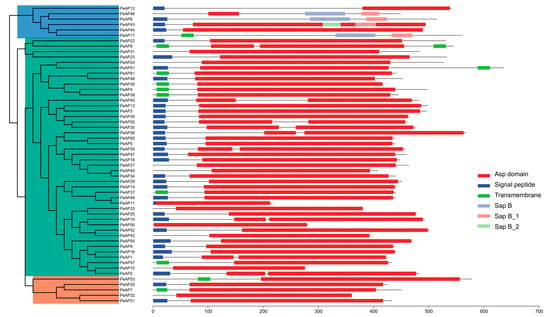
Figure 1
Open AccessArticle
Effects of Seedling Substrate and Hydroponic Versus Aquaponic Nutrient Solution on Growth, Nutrient Uptake, and Eco-Physiological Response of Lemon Basil (Ocimum × citriodorum)
by
Linda Signorini, Giuseppe Carlo Modarelli, Prospero Di Pierro, Antonio Luca Langellotti, Chiara Cirillo, Stefania De Pascale and Paolo Masi
Plants 2025, 14(13), 1929; https://doi.org/10.3390/plants14131929 - 23 Jun 2025
Abstract
Lemon basil (Ocimum × citriodorum) is a highly valued aromatic plant renowned for its distinct citrus aroma. This study aimed to evaluate sustainable substrates and cultivation systems for its production. Two complementary and sequential experiments were conducted: an initial experiment designed
[...] Read more.
Lemon basil (Ocimum × citriodorum) is a highly valued aromatic plant renowned for its distinct citrus aroma. This study aimed to evaluate sustainable substrates and cultivation systems for its production. Two complementary and sequential experiments were conducted: an initial experiment designed to compare coconut fiber mixed in varying proportions with perlite to rock wool, evaluating their effectiveness during germination and early growth (experiment 1), and a subsequent experiment aimed at assessing plant performance in a decoupled aquaponic system relative to hydroponics utilizing the best-performing coconut fiber-perlite mixture from the first phase along with rock wool as substrates (experiment 2). The substrate with 70% coconut fiber and 30% perlite (F70:P30) significantly improved seed germination, leaf number, and total leaf area of seedlings. The decoupled aquaponic cultivation system resulted in a 52.5% increase in flavonoid content, accompanied by higher calcium and magnesium uptake in stems and roots compared to hydroponics. These findings clearly underscore the potential of coconut fiber substrates mixed with perlite as sustainable alternatives to rock wool, reducing environmental impact, disposal costs, and health risks. Similarly, aquaponic cultivation emerges as a valuable strategy for sustainable lemon basil (Ocimum × citriodorum) production, offering comparable yields to hydroponics while improving plant nutritional and phytochemical quality through beneficial plant-microbe interactions. These results provide practical evidence supporting the adoption of environmentally friendly substrates and cultivation practices, thus contributing significantly toward sustainable intensive vegetable production systems.
Full article
(This article belongs to the Special Issue Driving Sustainability: Innovations in Producing Eco-Friendly Substrates for Soilless Culture Systems)
►▼
Show Figures
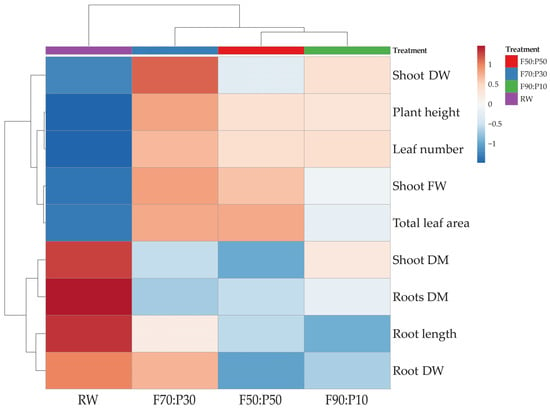
Figure 1
Open AccessReview
Reprogramming Hairy Root Cultures: A Synthetic Biology Framework for Precision Metabolite Biosynthesis
by
Chang Liu, Naveed Ahmad, Ye Tao, Hamad Hussain, Yue Chang, Abdul Wakeel Umar and Xiuming Liu
Plants 2025, 14(13), 1928; https://doi.org/10.3390/plants14131928 - 23 Jun 2025
Abstract
Hairy root cultures induced by Agrobacterium rhizogenes (Rhizobium rhizogenes) provide a sustainable approach to meet the growing demand for economically valuable plant-derived compounds in the face of depleting natural resources. These cultures exhibit rapid, hormone-independent growth and genetic stability, making them
[...] Read more.
Hairy root cultures induced by Agrobacterium rhizogenes (Rhizobium rhizogenes) provide a sustainable approach to meet the growing demand for economically valuable plant-derived compounds in the face of depleting natural resources. These cultures exhibit rapid, hormone-independent growth and genetic stability, making them viable for producing bioactive compounds, plant-specialized metabolites, and recombinant proteins. However, challenges remain in optimizing large-scale production, improving bioreactor efficiency, and enhancing metabolite synthesis across different plant species. This review addresses these challenges by exploring the mechanisms behind the induction of hairy root cultures, their applications in genetic and metabolic engineering, and their potential in environmental remediation. The review further highlights recent advances in biotechnology and illustrates how the hairy root system can sustainably meet industrial, pharmaceutical, and agricultural needs. In addition, by pointing out essential research areas such as optimizing culture conditions, increasing metabolite yields, and scaling up production, this work strengthens the significance of hairy root cultures in meeting the demand for high-value products while ensuring sustainable resource utilization. In particular, the integration of hairy root systems with advanced genomic tools such as transcriptomics and CRISPR technology holds immense potential for accelerating pathway-specific metabolic engineering, enhancing biosynthetic flux, and expanding their applications in sustainable agriculture and pharmaceutical innovation. This convergence is expected to drive substantial economic value by optimizing the production of high-value bioactive compounds, improving crop resilience, and facilitating precision medicine. Future work involving systems and synthetic biology will be instrumental in unlocking novel functions and ensuring broader deployment of hairy root cultures across industrial biotechnological platforms.
Full article
(This article belongs to the Special Issue Isolation and Characterization of Secondary Metabolites from Plants)
►▼
Show Figures
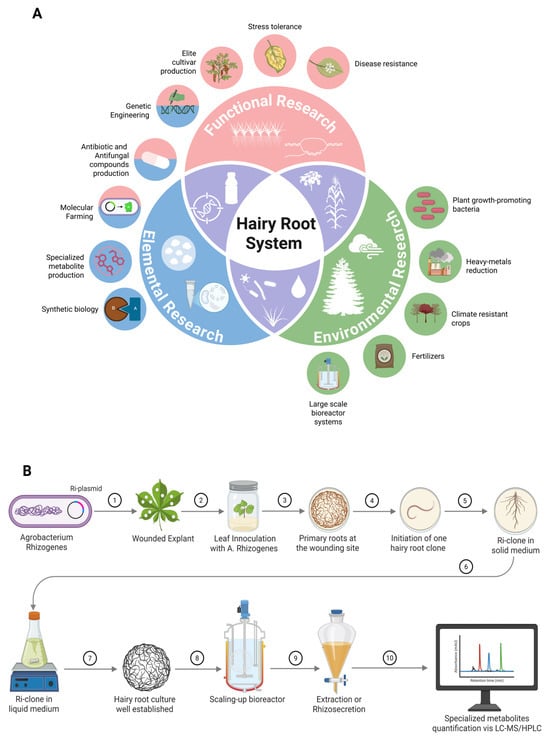
Figure 1
Open AccessEditorial
Responses of Crops to Abiotic Stress
by
Giora Ben-Ari and Georgios Koubouris
Plants 2025, 14(13), 1927; https://doi.org/10.3390/plants14131927 - 23 Jun 2025
Abstract
During recent years, agriculture has been undergoing a significant transformation in response to contemporary economic pressures and the escalating impact of climate change [...]
Full article
(This article belongs to the Special Issue Responses of Crops to Abiotic Stress)
Open AccessArticle
Rhizosphere Growth-Promoting Bacteria Enhance Oat Growth by Improving Microbial Stability and Soil Organic Matter in the Saline Soil of the Qaidam Basin
by
Xin Jin, Xinyue Liu, Jie Wang, Jianping Chang, Caixia Li and Guangxin Lu
Plants 2025, 14(13), 1926; https://doi.org/10.3390/plants14131926 - 23 Jun 2025
Abstract
The Qinghai–Tibet Plateau, a critical ecological barrier and major livestock region, faces deteriorating grasslands and rising forage demand under its harsh alpine climate. Oat (Avena sativa L.), valued for its cold tolerance, rapid biomass accumulation, and ability to thrive in nutrient-poor soils,
[...] Read more.
The Qinghai–Tibet Plateau, a critical ecological barrier and major livestock region, faces deteriorating grasslands and rising forage demand under its harsh alpine climate. Oat (Avena sativa L.), valued for its cold tolerance, rapid biomass accumulation, and ability to thrive in nutrient-poor soils, can expand winter feed reserves and partly alleviate grazing pressure on native rangelands. However, genetic improvement alone has not been sufficient to address the environmental challenges. This issue is particularly severe in the Qaidam Basin, where soil salinization, characterized by high pH, poor soil structure, and low nutrient availability, significantly limits crop performance. Rhizosphere growth-promoting bacteria (PGPR) are environmentally friendly biofertilizers known to enhance crop growth, yield, and soil quality, but their application in the saline soil of the Qaidam Basin remains limited. We evaluated two PGPR application rates (B1 = 75 kg hm−2 and B2 = 150 kg hm−2) on ‘Qingtian No. 1’ oat, assessing plant growth, soil physicochemical properties, and rhizosphere microbial communities. The results indicated that both treatments significantly increased oat productivity, raised the comprehensive growth index, augmented soil organic matter, and lowered soil pH; B1 chiefly enhanced above-ground biomass and fungal community stability, whereas B2 more strongly promoted root development and bacterial community stability. Structural equation modeling showed that PGPR exerted direct effects on the comprehensive growth index and indirect effects through soil and microbial pathways, with soil properties contributing slightly more than microbial factors. Notably, rhizosphere organic matter, fungal β-diversity, and overall microbial community stability emerged as positive key drivers of the comprehensive growth index. These findings provide a theoretical basis for optimizing PGPR dosage in alpine forage systems and support the sustainable deployment of microbial fertilizers under saline soil conditions in the Qaidam Basin.
Full article
(This article belongs to the Special Issue Advanced Research on Rhizosphere Microorganisms: Plant–Microbial Interactions and Sustainable Agriculture)
►▼
Show Figures
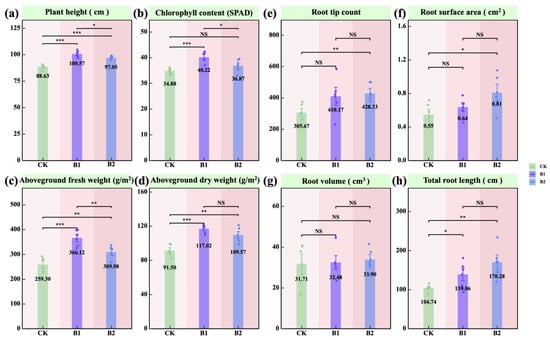
Figure 1
Open AccessArticle
Rhizosphere and Non-Rhizosphere Soil Microbial Communities in Alpine Desertified Grassland Affected by Vegetation Restoration
by
Xuan Gao, Hongyu Qian, Rui Huang, Wangyi He, Haodong Jiang, Ao Shen, Zhi Li and Yufu Hu
Plants 2025, 14(13), 1925; https://doi.org/10.3390/plants14131925 - 23 Jun 2025
Abstract
The rhizosphere serves as a critical interface for plant–soil–microorganism interactions. Rhizosphere soil refers to the soil directly adhering to root surfaces, while non-rhizosphere soil denotes the surrounding soil not in direct contact with roots. This study investigated the characteristics of soil microbial community
[...] Read more.
The rhizosphere serves as a critical interface for plant–soil–microorganism interactions. Rhizosphere soil refers to the soil directly adhering to root surfaces, while non-rhizosphere soil denotes the surrounding soil not in direct contact with roots. This study investigated the characteristics of soil microbial community structure, diversity, and enzyme activity dynamics in both rhizosphere and non-rhizosphere soils of Salix cupularis (shrub) across different restoration periods (4, 8, 16, and 24 years) in alpine sandy lands on the eastern Qinghai–Tibet Plateau, with unrestored sandy land as control (CK), while analyzing relationships between soil properties and microbial characteristics. Results demonstrated that with increasing restoration duration, activities of sucrase, urease, alkaline phosphatase, and catalase in Salix cupularis rhizosphere showed increasing trends across periods, with rhizosphere enzyme activities consistently exceeding non-rhizosphere levels. Bacterial Chao1 and Shannon indices followed similar patterns to enzyme activities, revealing statistically significant differences between rhizosphere and non-rhizosphere soils after 8 and 24 years of restoration, respectively. Dominant bacterial phyla ranked by relative abundance were Actinobacteria > Proteobacteria > Acidobacteria > Chloroflexi > Gemmatimonadetes. The relative abundance of Actinobacteria exhibited highly significant positive correlations with carbon, nitrogen, phosphorus, and enzyme activity indicators, indicating that Salix cupularis restoration promoted improvements in soil physicochemical properties and nutrient accumulation, thereby enhancing bacterial community diversity and increasing Actinobacteria abundance. These findings provide fundamental data for restoration ecology and microbial ecology in alpine ecosystems, offering a scientific basis for optimizing ecological restoration processes and improving recovery efficiency in alpine sandy ecosystems.
Full article
(This article belongs to the Special Issue Strategies to Improve Vegetation Restoration, Alleviate Land Degradation, and Sustainable Management in the Desert Ecosystem)
►▼
Show Figures
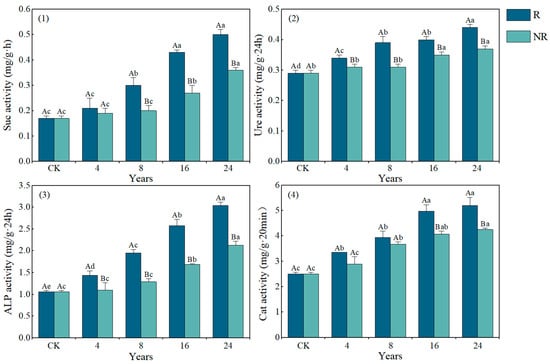
Figure 1

Journal Menu
► ▼ Journal Menu-
- Plants Home
- Aims & Scope
- Editorial Board
- Reviewer Board
- Topical Advisory Panel
- Instructions for Authors
- Special Issues
- Topics
- Sections & Collections
- Article Processing Charge
- Indexing & Archiving
- Editor’s Choice Articles
- Most Cited & Viewed
- Journal Statistics
- Journal History
- Journal Awards
- Society Collaborations
- Conferences
- Editorial Office
Journal Browser
► ▼ Journal BrowserHighly Accessed Articles
Latest Books
E-Mail Alert
News
Topics
Topic in
Agriculture, Agronomy, Horticulturae, Plants
Optimizing Plants and Cultivation System for Controlled Environment Agriculture (CEA)
Topic Editors: Linxuan Li, Yongming Liu, Xiumei Luo, Maozhi Ren, Xiulan Xie, Jie HeDeadline: 3 July 2025
Topic in
Agriculture, Agronomy, Crops, Horticulturae, Plants
Sustainable Crop Production from Problematic Soils to Ensure Food Security
Topic Editors: Zhongbing Chen, Safdar Bashir, Saqib BashirDeadline: 12 July 2025
Topic in
Agriculture, Agronomy, Forests, Plants, Stresses
The Effect of Climate Change on Crops and Natural Ecosystems, 2nd Volume
Topic Editors: Arnd Jürgen Kuhn, Giuseppe FenuDeadline: 31 July 2025
Topic in
Climate, Diversity, Forests, Plants, Sustainability, Earth
Responses of Trees and Forests to Climate Change
Topic Editors: Qinglai Dang, Ilona Mészáros, Lei WangDeadline: 30 August 2025

Conferences
Special Issues
Special Issue in
Plants
Green Machines: Understanding the Interplay Between Natural and Human-Induced Factors on Plant Life
Guest Editor: Ma. Luisa MartínezDeadline: 27 June 2025
Special Issue in
Plants
Remote Sensing-Based Monitoring of Vegetation Phenology in a Changing Environment
Guest Editors: Jing Xie, Zhi DingDeadline: 30 June 2025
Special Issue in
Plants
Diversity and Classification of Bryophytes
Guest Editor: Vítězslav PlášekDeadline: 30 June 2025
Special Issue in
Plants
Invasive Alien Plant Species: From Phytochemical Diversity to Ecological Management
Guest Editors: Vladimir Vladimirov, Ekaterina KozuharovaDeadline: 30 June 2025
Topical Collections
Topical Collection in
Plants
Plant Morphofunctional and Evolutionary Traits under a Climate Change Scenario
Collection Editors: Luigi Sanita' di Toppi, Howard S. Neufeld, Yasutomo Hoshika, Mirwais Qaderi
Topical Collection in
Plants
Selected Papers from Lithuanian Research Centre for Agriculture and Forestry
Collection Editors: Giedrė Samuolienė, Gražina Kadžienė, Darius Kviklys, Neringa Rasiukeviciute
Topical Collection in
Plants
Feature Papers in Plant Ecology
Collection Editors: Ismael Aranda, Fernando Henrique Reboredo, Roberta Masin








